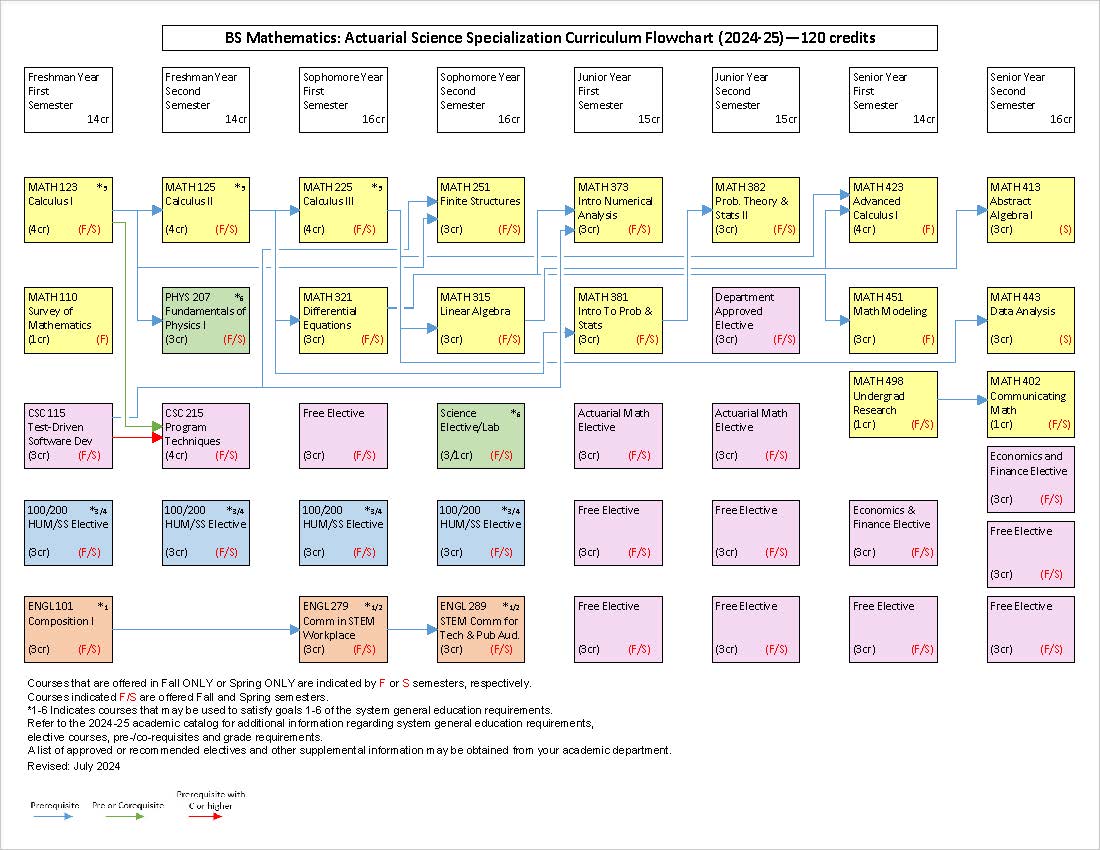| |
| |
Dec 14, 2025
|
|
|
|
|
2024-2025 Academic Catalog [ARCHIVED CATALOG]
Mathematics: Actuarial Science Specialization, BS
|
|
Contact Information
Travis Kowalski, Department Head
Mathematics
McLaury 206C
(605) 394-2471
E-mail: Travis.Kowalski@sdsmt.edu
Department Website
Students are responsible for checking with their advisors for any program modifications that may occur after the publication of this catalog.

MATH-AS Flowchart
|
Curriculum Checklist
A specialization is considered a separate major in South Dakota Mines’ student record system. In order to pursue this specialization, please request a change of major even if you are currently pursuing a major in the non-specialized version of Mathematics . Notes:
For the bachelor of science in Mathematics, a student must have a departmental grade point average of at least 2.00 in all MATH courses 300 level or higher. 1 Fulfills General Education requirement. Students should consult the “General Education Requirements” section of this catalog for a complete listing of all general education requirements. 2 The CSC 115 requirement can also be fulfilled by either CSC 150/150L or CSC 170/170L . The CSC 215 requirement can be fulfilled by CSC 250. However, to prevent prerequisite conflicts with potential later electives, it is recommended that Mathematics majors take CSC 115 and CSC 215. 3 Select one course from BIOL 151 , BIOL 153 , CHEM 112 , CHEM 114 , GEOL 201/201L ,or PHYS 209 , and one lab in BIOL 151L , BIOL 153L , CHEM 112L , CHEM 114L , PHYS 207L , or PHYS 209L (GEOL 201/201L must be taken co-requisitely regardless). 4 Select two courses from CSC 484 Database Management Systems , ENGM 435/535 Optimization Techniques , IENG 362 Stochastic Models , or IENG 415/515 Decision Analysis 5 Select two courses from ACCT 210 Principles of Accounting I, ACCT 211 Principles of Accounting II, BADM 310 Business Finance, or IENG 302 Engineering Economics . ACCT 210, ACCT 211, and BADM 310 are offered through other BOR schools. 6 Select three credits from the list of Department Approved Electives below. Department Approved Electives
Select three credits from the list below: MATH: MATH 415/515 , MATH 421/521, MATH 424 , MATH 432/532, MATH 443/543, MATH 447/547, MATH 451/551, MATH 452/552 AES: AES 401/501, AES 404/504, AES 419/519, AES 430/530, AES 455/455L/555/555L BIOL: BIOL 480/580 BME: BME 300, BME 303, BME 304, BME 305, BME 306, BME 402/402L, BME 403, BME 404/404L CBE: CBE 317, CBE 318, CBE 321, CBE 343, CBE 417, CBE 424/524, CBE 433, CBE 444/544, CBE 445/545, CBE 450/550, CBE 484/584, CBE 488/588 CEE: CEE 336/336L, CEE 433/533, CEE 457/557, CEE 468/568, CEE 475/475L/575/575L CENG: CENG 320/320L, CENG 420, CENG 421/521, CENG 444/544, CENG 452 CHEM: CHEM 342 , CHEM 344 CSC: CSC 315, CSC 372, CSC 412/512, CSC 414/514, CSC 416/516, CSC 424/524, CSC 433/533, CSC 445/545, CSC 448/548, CSC 449/549, CSC 454/554 EE: EE 313, EE 314/314L, EE 362, EE 381, EE 382, EE 404/504, EE 421/521, EE 447/547, EE 448/548, EE 449, EE 451, EE 452/552, EE 453/453L/553/553L, EE 456/456L/556/556L, EE 481/481L/581/581L, EE 483/483L/583/583L EM: EM 321, EM 328, EM 331 ENGM: ENGM 435/535 GEOE: GEOE 475/475L/575/575L GEOL: GEOL 419/519 , GEOL 450 IENG: IENG 362, IENG 415/515, IENG 425, IENG 441 ME: ME 312, ME 313, ME 316, ME 331, ME 352, ME 402/502, ME 404, ME 419, ME 423, ME 425, ME 428/428L/528/528L, ME 430 , ME 444/544, ME 453/453L/553/553L, ME 455/455L, ME 457/557, ME 460 MEM: MEM 410/510, MEM 425/525, MEM 445/545/445L/545L, MEM 450/550 MET: MET 310, MET 320, MET 330, MET 321 , MET 321L , MET 422, MET 433, MET 440/540, MET 443, MET 445/545 NANO: NANO 401 , NANO 445/545 , NANO 571 PHYS: PHYS 341, PHYS 343, PHYS 361, PHYS 404/504, PHYS 421/521, PHYS 439/539, PHYS 445/545, PHYS 451/551, PHYS 471/571, PHYS 481/581 Objectives and Outcomes
Student Outcomes: - Students will use mathematics to effectively formulate and solve problems, including (but not limited to) those that arise in mathematics, science, and engineering.
- Students will critically interpret data and analyze solutions.
- Students will apply appropriate mathematical software to solve problems arising in the profession.
- Students will collaborate with colleagues and communicate ideas using appropriate mathematical language and notation, both orally and in writing.
|
|
|
|